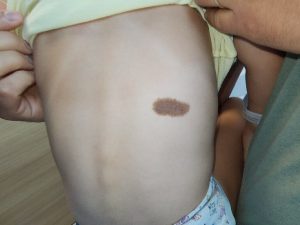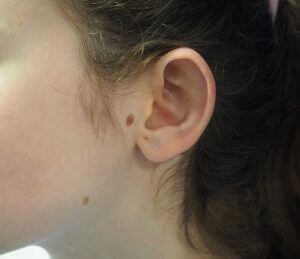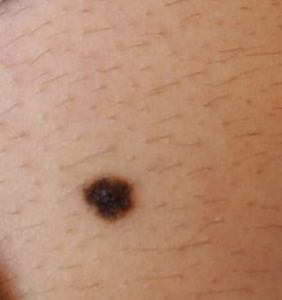
Everything you need to know about moles (beauty marks) in children
Prior to writing this chapter, we contemplated whether we should write a single post discussing the different types of birthmarks in children or divide the topic into two posts – one about congenital moles and one about acquired moles. We considered writing two posts because there is a difference between congenital moles and those that appear later in life. However, in the end, we decided to discuss both in a single post because we felt like the two were more similar than they were different.
The aim of this chapter is to provide you with the tools to understand and manage moles. This chapter was written by Dr Asaf Olshinka, a senior pediatric surgeon and you can read more about him in the link here.
What is the prevalence of moles (beauty marks) in children?
Moles, or beauty marks, are found in approximately 1% of neonates. Congenital moles come in different sizes – they can be small (1.5 cm), medium, large, or giant. See the first images attached of a medium congenital mole.
Beauty marks continue to appear on children’s and adolescent’s bodies over the years and they can increase in size as the child ages.
The average adult has between 10-40 moles.
What is a mole/beauty mark?
Moles (melanocytic nevus) are skin lesions made up of a group of non-cancerous cells that produce the melanin pigment. These cells replicate in one region to produce a mole.
A regular mole is one that is symmetrical in appearance, has a consistent colour, and is smaller than 6mm. See the image attached.
A dysplastic or atypical mole is one that does not look like a typical mole and has one of the following characteristics – asymmetrical, unclear borders, contains multiple colours and is greater than 6mm in size. Signs of atypical or irregular moles can be remembered with the help of the ABCDE rule: Asymmetry, Borders (irregular edges and corners), Colour (variegated), Diameter (greater than 6mm) and Evolving over time. Take a look at the image attached of a dysplastic mole – it is large in size, has multiple colours and irregular borders.
Additionally, it is also important to follow any changes that may occur to the moles over time and to compare its appearance to the other moles on the child’s body.


What is melanoma and how is it related to moles?
Melanoma is a type of skin cancer. Sadly, it is malignant and dangerous, can metastasize and be fatal. In some cases, melanoma develops from a regular mole that has undergone changes.
The earlier the melanoma is detected, the greater the chances of full recovery.
Is melanoma common in children?
Statistically speaking, melanoma is very rare in children. But because melanoma is a dangerous tumor and early detection is vital for treatment, it is important to seek medical attention whenever a mole seems suspicious.
Are moles only a cosmetic concern?
In addition to the cosmetic concern that moles carry, it is important to keep in mind, as mentioned above, that they also carry a risk of developing into cancerous lesions.
The risk of cancer is greater in congenital moles when compared to the acquired moles that appear later in life. This risk is the reason behind the need for medical monitoring of both congenital and acquired moles, and the need to consider their surgical removal.
It must be emphasized that one cannot foresee which congenital mole will undergo changes and become cancerous in the future. However, the risk is always there – and that is why these moles need to be either monitored regularly or removed. So, there is a cosmetic concern, yes, but that is not why these moles need to be treated.
What do I need to do if my child has a mole with an irregular appearance?
If the mole has an irregular appearance, you need to see a dermatologist or plastic surgeon who will determine whether a small surgical procedure for removal and biopsy of the lesions is required. Some cases only need surveillance.
How are moles removed in children?
The only way to remove a suspicious mole is resection through a surgical procedure. The piece resected is then sent for biopsy and the diagnosis is determined. All the other techniques (freezing, burning, using ointment, not sending for biopsy) are dangerous because we will not be able to tell whether the lesion is cancerous and whether the entirety of it was removed.
When considering these techniques in children, we have to think about whether the child is physically and mentally capable of undergoing the procedure. The surgeon needs to determine whether local or general anesthesia will be needed.
What about the use of laser treatment for the removal of moles?
This is a very problematic issue. Generally, the burning of a pigmented mole is forbidden.
Proper usage of laser beams to cut or shave off a mole is an option but is not preferred over surgical resection when it comes to cosmetic outcomes.
At what age should the surgical resection of moles be considered?
Keep in mind that the purpose of resection of the mole is to decrease the chances of cancerous evolvement and to improve aesthetics.
Therefore, the decision for surgical removal, the type of surgery and the timing will need to take into consideration the chances for development of melanoma, scarring, the potential for development of disorders following treatment and the cosmetic outcomes of treatment.
As a rule of thumb, removal of a small congenital mole can be postponed to when the child is old enough to have it removed under local anesthesia (since these small lesions have a small chance of evolving into cancerous lesions anyway). These congenital moles need to be monitored regularly until they are removed. If the mole is large or irregular, or located in an area that makes it harder to monitor regularly, then earlier removal is advised.
Why is a pediatric plastic surgeon preferred in children?
Pediatric plastic surgery provides us with the opportunity to treat and correct problems in children, before they grow into adults. Children are not small adults, especially when it comes to plastic surgery. Pediatric plastic surgeons complete training in plastic surgery specifically catered to children, and they are capable of providing care that takes the child’s physical growth and emotional maturity into consideration. It is important that the medical professional is familiar with medical issues that are specific to children. There are cases where monitoring and surveillance are sufficient and there are other situations when surgery must be carried out. It also takes experience to determine the type of surgery and anesthesia that is best for the child.
In summary, removing moles in children is a simple procedure, and it is carried out when there is a concern that the mole may develop into a cancerous lesion such as malignant melanoma. Despite it being a relatively simple procedure, it is preferable to have an experienced, pediatric plastic surgeon perform it.
For comments and questions, please register
